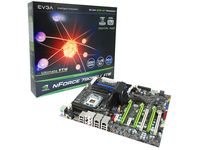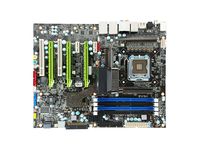EVGA's New 790i Motherboard Should Delight Overclockers
EVGA has announced a new motherboard based on Nvidia’s popular nForce 790i SLI chipset. The EVGA 790i SLI FTW Digital PWM supports DDR3 memory, a 1,600MHz front-side bus, PCI Express 2.0, and—according to EVGA—a bevy of electronic, mechanical, and BIOS features to facilitate aggressive overclocking.
Digital power management is this socket-775 board’s primary claim to fame. EVGA maintains that giving the user precise control over how the high-voltage power line is stepped down to the required processor core voltage will provide increased stability while overclocking (the PWM acronym in the $340 board’s name stands for pulse width modulation; we can guess what FTW stands for). EVGA claims that their use of solid-state capacitors and 100-percent ferrite-core chokes should also improve the board’s signal-to-noise ratios in extreme overclocking situations.
The 790i Digital PWM will also allow experienced overclockers to disable Vdroop from within the BIOS. Vdroop is a design feature inherent to Intel’s CPU architecture; it protects the CPU from voltage spikes as the processor swings between light and heavy workloads. EVGA maintains that Vdroop can be a problem for aggressive overclockers. If you increase the core voltage to 1.5 volts, for example, Vdroop might overcompensate during one of these workload swings and cause voltage to the core to momentarily sag to 1.4 volts, causing the system to become unstable. With Vdroop disabled, according to EVGA, voltage flowing to the core should remain relatively constant. EVGA reasons that overclockers will equip their rigs with improved cooling solutions and better-quality power supplies, factors that they believe render Vdroop unnecessary.
Those interested in achieving the benefits of overclocking without the risk of blowing up their computer, on the other hand, will appreciate the noob-friendly features in EVGA’s BIOS, including a collection of pre-validated voltage settings that will deliver five to 25-percent overclocking without risk.
And for those who prefer to benchmark their components without mounting everything inside a case, the motherboard features power-on and reset buttons right on the PCB; the power-on button even has an integrated hard drive activity LED. Another button will reset the board’s CMOS values. Other hardware features on the motherboard include the presence of two 1GB NICs, nine SATA ports, 10 USB 2.0 ports, an onboard LED for displaying POST codes, and four DIMM slots to accommodate up to 8GB of DDR3 memory running at up to 2GHz in dual-channel mode.
Get Tom's Hardware's best news and in-depth reviews, straight to your inbox.
-
one-shot I'm weary of Nvidia chipsets. My first motherboard had a 570 chipset. I'll stick with Intel..for awhileReply -
donkeypunch Yep, I'll never go back to Nvidia boards. I got stuck with a 680i board because the builder had no x38's or P35's at the time. I never intended to use SLI but my biggest disappointment was the lousy memory support. If I use 4 Dimms its unstable, if I use 2 Dimms and try to run anything over 800mhz its unstable. Many forums report using 2.2 or more volts will fry your memory over time. Just a lousy memory controller. Intel only from now on for me.Reply -
roofus been running a 780i board without incident. overclocks very good and is very stable. i would definitely agree with donkeypunch on the voltage to the memory controller. they are very delicate.Reply -
jaragon13 Great design/idea,shitty ass Nvidia chipset which is old/buggy/slow and based on the ever monolithic 90nm process...And these new additions do what? Make it equal to that of the last generation of Intel motherboards?Reply -
anonymous x ??? most reviews I have read show the 790i ultra chipset to be better than X38, dunno why all the negative commentsReply -
ilovebarny i just got my E6750 to 3.6 ghz with the fsb set at 1750 mhz. on a 680i mobo. evan got my ocz ram (3gb) to 1066mhz from 800mhz, it wont go any farther though on the ram.Reply -
baseline Nice enough board great features and all but what's the point? We are about one month away from i7 and not only a new socket but new architecture as well. Considering this board is aimed at the high end who in this market segment is going to spend $340.00 for a mb when the socket will essentially be obsolete in a month?Reply -
giovanni86 i am...... I hate obsolete... But i have no choice. The price will drop as soon as the new socket comes around.Reply -
jaragon13 Why pay 400 dollars for a board which has the efficiency incredibly worse than that of the competitors? Do you know how many problems I've had with Nvidia chipsets? Sure,you can overclock a conroe to 3.6Ghz.Good for you.Reply
I could do the same with a Pentium D.
Overclocking is not always the determining factor of a good motherboard.

